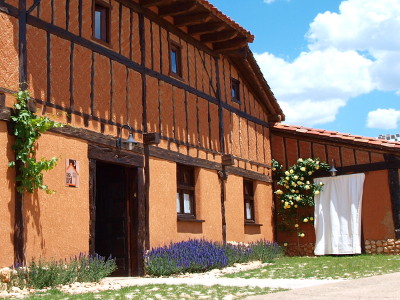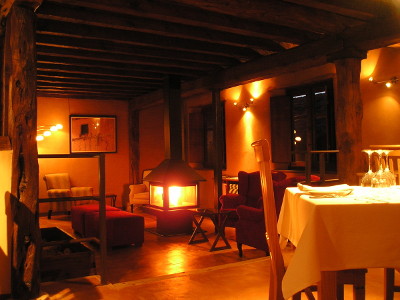Canyon of wolves and vultures
El Cañón del Río Lobos
Wildlife and ecosystems
This page offers a longer description of the ecosystems and wildlife that characterise the Rio Lobos Canyon Natural Park. The main information source has been the park's Natural Resource Management Plan, Volume I, Inventory, published in February 2010.
A spectacular landscape and complex ecosystem
The province of Soria is a historic land with a great natural and cultural heritage, and the canyon of the river Lobos is arguably its finest example of a spectacular landscape, sculpted by nature's wild forces, harbouring a vibrant and complex ecosystem inhabited by an impressive array of plant and animal species, and bearing the traces of man's presence from prehistoric times to the present day.
The river Lobos (lobo means wolf in Spanish) rises in the province of Burgos and at Hontoria del Pinar is engulfed by pine woods as it starts to cut its way into the limestone plateau. 25 km later, after winding through an ever deepending gorge, it arrives at the Galiana pass at Ucero, where the towering rock walls reach heights of more than 100 m, and the landscape suddenly opens up to give way to the wide arable flood plain of the river Ucero.
The canyon and its surrounding area form part of a regional 'Parque Natural', and its conservation and management are the responsibility of the regional government of Castile and Leon. The park was constituted in 1985 and comprises an area of close to 10,000 hectares. In 2000 it was also declared a Special Protection Area for birds, in accordance with the EU Birds Directive, and together with the adjoining Sierra de Cabrejas has been proposed as a Site of Community Interest to form part of the Natura 2000 network, in accordance with the EU Habitats Directive.
The protected zone includes large areas of pinewoods, particularly Pinus nigra and Pinus sylvestris, in the northern and western part of the park, and incense juniper (Juniperus thurifera) woodlands and scrub in the eastern and southern part. There are also some smaller patches of land given over to agriculture and cattle pasture. But the heart of the park, and its greatest treasure, is the actual gorge of the river Lobos.
Textbook physical geography
The landscape reads like a physical geography textbook, bringing to life those old diagrams of caves and chasms, swallow holes, and limestone pavements with their clints and grykes. The gorge is the result of a slow process of erosion by abrasion, freeze-thaw, and above all dissolution of the rock by rainwater seeping in through millions of tiny cracks and crevices, undermining the plateau with hundreds of caverns and tunnels that have successively caved in over time, gradually lowering the level of the river bed and deepening the gorge.
The karstic nature of the terrain, together with the low rainfall that characterises the local climate, means that the river Lobos is largely an underground river and only flows on the surface after prolonged wet periods. In fact, the river bed in the upper part of the canyon is just a trail of dry boulders for much of the year. On the central and lower stretches the river is often reduced to a trickle in the summer months, its course dotted with lilly-pad-covered pools like oases in the desert. Heavy spring rains can cause the water level to rise considerably, making the main route through the canyon impassable at times. This is when the karst landscape really comes to life, as raging streams are guzzled up by swallow holes and water wells up through the ground in the most unsuspected of places. The end of the canyon is also the end of the river Lobos, as it reaches the gushing springs of the river Ucero's source at the foot of the Galiana pass.
The vegetation of the canyon changes from the dense, shady pinewoods at its upper end to the patchy vegetation characteristic of incense juniper scrub at its lower end. As we descend through the gorge, rocky outcrops start to emerge between the pine trees, and the spectacularity of the landscape gradually increases until reaching its grand crescendo in the vicinity of Ucero. There are also a number of excellent panoramic viewpoints at different places in the park, notably the popular Galiana viewpoint overlooking the bottom section of the canyon, the village and castle of Ucero, and southwards over the Ucero river valley; and the far less well known Costalago viewpoint, again looking south over miles of woodland, where the silence is interrupted only by the distant clanging of cowbells from the pastures at the foot of the hill.
Wolves, bats and the Pyrenean desman
The park is an important wildlife reserve, with many protected species of mammals, amphibians, reptiles and fish.
The woodland and scrub around the canyon harbours a number of large mammals, such as wild boar, roe deer and red deer, foxes, badgers and hares. The presence of a stable population of wolves in this area is not officially recognised, but the wolf is included in the park's scientific inventory and there is evidence to suggest it is a frequent visitor, if not a permanent fixture. Other species resident in the park include wild cat and red squirrel, and in recent years the common genet has been detected. It is also encouraging to report that the numbers of Pyrenean desman (a small semiaquatic nocturnal mammal related to moles and shrews) and otters in the river Lobos seem to be increasing. The bat population in the park is of particular significance, and at least 14 of the 26 species of bats in the Iberian Peninsula have been cited in the canyon.
The park is a suitable environment for many reptile species. A number of snakes can be seen, including the Southern smooth snake, Montpellier snake, grass snake, viperine snake, slow worm, and the vulnerable snub-nosed adder (Vipera latastei). Lizards can be found in several habitats and include both the common wall lizard and the endangered Iberian wall lizard (Podarcis hispanica)
, as well as the Spanish psammodromus, Western green lizard and the vulnerable Ocellated lizard (Lacerta lepida). Pools along the river Lobos are inhabited by the near threatened European pond terrapin (emys orbicularis) and in the damp, sunny meadows along the banks of the river it is possible to see the Western three-toed skink (Chalcides striatus), which superficially looks like a snake except for the presence of two pairs of tiny, three-toed limbs.
Amphibians in the park include Perez's frog, the European tree frog, Palmate newt and several species of toads including the Natterjack toad (bufo calamita). The crystal clear waters of the river Lobos are home to a healthy riverine community including fish in vulnerable and endangered states of conservation such as Brown trout, Bermejuela (Rutilus arcasii), Lamprehuela (Cobitis calderoni) and Boga del Duero (Chondrostoma duriense).
Vulture gulch
With a resident population of 135 nesting couples, the Griffon Vulture is the star of the show for most visitors to the Canyon. The park is also a habitual breeding ground for the Egyptian Vulture, with 7 nesting couples, and home to 130 pairs of Choughs that comprise a community of regional, national and international interest.
Other relevant birds of prey include 2 nesting couples of Golden Eagles, 5 nesting couples of Peregrine Falcons, and 3 couples of Eagle Owls. Historically the area has also been a breeding ground for Bonelli's Eagle, though their presence in the park is now only occasional. It is also possible to see groups of Lesser Kestrels after the breeding season, and occasional sightings of Little Bustard and Black-bellied Sandgrouse have been reported. Montagu's Harrier and Hen Harrier also nest in the area around the park and are common visitors on their migrations.
Among the 151 species of birds catalogued as residents or visitors to the park, other breeding species of interest include: Black kite, Red kite, Short-toed Eagle (3 couples), Booted Eagle (3-5 couples), Nightjar, Kingfisher, Short-toed Lark, Thekla Lark, Wood Lark, Tawny Pipit, Dartford Warbler, Red-backed Shrike, Ortolan Bunting, Goshawk, Sparrow Hawk, Hobby, Alpine Swift, Redstart, Rock Thrush, Blue Rock Thrush, Goldcrest and Citril Finch. Dippers have bred in the area around the source of the river Ucero, and the park is a common wintering ground for Wall Creeper, Alpine Accentor, Merlin and -more occasionally- Short-eared Owl.
Butterflies and moths
Inside the park there are at least 98 species of day-flying lepidoptera. Among the Papilionidae, Zerynthia rumina (Spanish Festoon) is a threatened species on the Red List of Iberian Butterflies. Among the Nymphalidae it is surprising to find a number of species typical of Northern Spain and even Central Europe, such as the Heliconiiae Brenthis daphne (Marbled Fritillary), B. ino (Lesser Marbled Fritillary), Boloria euphrosyne (Pearl-bordered Fritillary) and B. dia (Violet Fritillary). Another common species of Nymphalidae is Euphydryas aurinia (Marsh Fritillary), which is protected by the Habitats Directive. The most outstanding Satyrinae include Brintesia circe (Great Banded Greyling), Coenonympha dorus (Dusky Heath), C. glycerion (Spanish Heath) and Hyponephele lupina (Oriental Meadow Brown).
Attention is also drawn to other species of interest in view of their limited distribution, such as Polyommatus dorylas (Turquoise Blue), Celastrina argiolus (Holly Blue), Glaucopsyche melanops (Black-Eyed Blue), Lycacena virgaureae (Scarce copper), L. phlaeas (Small Copper) and Thecla quercus (Purple Hairstreak), or for their rarity, such as Polyommatus thersites (Chapman's blue). In the lower reaches of the park it is possible to observe one of Europe's largest moths, Saturnia pyri (Great Peacock), which is increasingly rare due to the use of insecticides and pesticides and is protected in Spain.
The presence of man
The Rio Lobos park today draws large numbers of visitors from far and wide, but the Canyon has exerted an irresistible attraction to humans since prehistoric times, and people have been leaving their mark since the earliest settlers in the area.
Traces of ancient habitation have been found in many of the canyon's caves, from Stone-Age tools to Bronze-Age ceramics. Iron-Age man scratched enigmatic engravings into the walls of Cueva Grande and daubed oxide paints onto the walls of Cueva Conejos. Iron-Age communities moved out of the caves and onto hilltop sites, and hill-forts were established at Castillo Billido and Ucero, and the Celtic necropolis of San Martin close to Ucero has yielded large amounts of funerary artefacts.
The Romans established a number of farms and villas along the Ucero valley and famously at nearby Santervás, and remains of Roman occupation have also been found at the Castillo Billido site overlooking the central stretch of the Canyon. The Roman road network gave access to the marble quarries at nearby Cantalucia, Espeja and Espejón, and at Hontoria del Pinar, at the top end of the Canyon, it is still possible to follow a stretch of Roman road and cross the old Roman bridge. Another very significant and fascinating Roman site is the stretch of tunnel pertaining to the 1st Century Ucero-Uxama canal which can be visited close to Ucero.
The Canyon has always been an important throroughfare connecting the lowlands of the Douro plain with the summer pastures in the Sierra de la Demanda hills, and ancient drover's roads marked out in the Middle Ages cross the park at several points. Also from the Medieval period is the castle at Ucero and the enigmatic Templar chapel of San Bartolomé at Cueva Grande.
The small farming communities surrounding the park were mostly founded in the 12th Century as the Christian reconquest of Spain pushed its way south, bringing colonists down from Cantabria and the Basque Country. Life in these communities went on in much the same way for many hundreds of years, and traditional farming practices shaped the countryside we know today. Farm mechanisation in the 20th Century led to an exodus that put an end to the traditional way of life, posing many challenges to the conservation of plant and animal species in the area.


